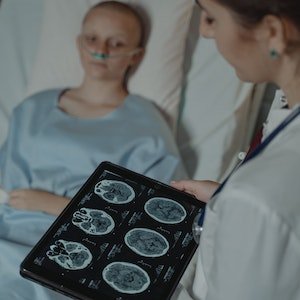Glioblastoma is the most aggressive type of brain cancer. You can take specific steps to increase your chances of survival if you have this type of tumor.
Glioblastomas are rare in adults younger than 55, accounting for only about 10% of all primary brain tumors. But in people 55 and older, glioblastoma is more common — accounting for nearly half of all primary brain tumors in this age group.
According to the American Cancer Society, only about 10% of people diagnosed with glioblastoma are over age 65.
In general, malignant brain tumors are often a consequence of the natural process of aging. As we age, our brain accumulates damage from normal aging processes, such as inflammation and oxidative stress. This damage may result in DNA mutations that trigger tumor growth.
This article will help you with very commonly asked doubts related to glioblastoma.
What is Glioblastoma?
Cancer is a condition in which cells in the body grow out of control. Glioblastoma is a type of cancer that begins in the brain. Also, glioblastoma starts from glial cells, an essential part of nerve cells.
Glioblastoma multiforme is the cancerous cells that spread into the brain and rapidly increase and spread the infection into glial cells.
Glioblastoma can start in the brain or the spine and spread (metastasize) to other parts of the brain and spine. Moreover, Glioblastoma is the most common and aggressive type of brain cancer.
It is scarce in younger adults but relatively common in adults 55 and older. In older adults, glioblastoma is about half of all brain tumors.
What are the Symptoms of Glioblastoma?
The signs and symptoms of glioblastoma vary from person to person. The main symptom is a change in mental function, such as :
- Confusion
- Impaired thinking
- Personality changes
Other symptoms may include:
- Headaches
- Seizures
- Loss of balance
- Trouble walking
Symptoms may come on suddenly or progress slowly over time. The symptoms of glioblastoma often cannot be detected on a brain scan.
A brain scan can help rule out glioblastoma and determine the grade of the tumor (low grade or high grade).
What are the Treatments for Glioblastoma in Older Adults?
The treatment of glioblastoma in older adults is often chemotherapy and surgery to remove the visible tumor mass.

Treatment for glioblastoma varies from person to person.
Treatments may vary depending on the size and location of the tumor, the person’s health, and their prognosis.
- Chemotherapy: It is a common method to treat glioblastoma in older adults because it can work to kill cancer cells when the location of the tumor is unknown. Chemotherapy drugs are given intravenously (IV) into a vein. The drugs travel throughout the body, including the brain. However, chemotherapy is not practical for treating glioblastoma when the tumor is more significant than 2 cm.
- Surgery: Surgery is the first treatment for glioblastoma in older adults. It may be useful to confirm the diagnosis, determine the size and location of the tumor, or remove as much cancer as possible. Besides, surgery may also relieve symptoms caused by the tumor, such as seizures, headaches, or problems with movement or sensation. Also, surgery is sometimes applicable to relieve pressure from the tumor on the surrounding brain tissue.
- Radiation: Radiation therapy helps in damaging cancerous cells as they cannot regrow or spread more into different areas of the brain using S-rays.
- Tumor treatment fields: Wearable devices that send low-intensity electrodes into the scalp so that it damages the cancerous cell and prevents in regrow or spread of the tumor.
- Stereotactic radiosurgery: Gamma knife radiosurgery is a form of sophisticated radiation therapy. Stereotactic radiosurgery. It is not a surgical operation, despite the term. X-ray beams that are highly focused precisely target the tumor, causing minimal harm to healthy tissue. Providers occasionally use this method when GBM progresses following the first IMRT.
Every treatment has side effects, and it is necessary to manage them effectively and cautiously. So, let’s be aware of what might be the problem and how to solve them.
Must Read- Top Superfoods to Boost your Brain Power
How to Manage the Side Effects of Glioblastoma Treatment in Older Adults?
Side Effects for the treatment might vary in different ways in different cases; some of the common side effects of glioblastoma treatment include:
- Nausea and vomiting: You may want to try eating small meals. Avoid drinking alcohol, which can make nausea worse. If nausea is severe and does not improve after a few days, talk to your healthcare provider. Discuss medications that can help relieve these symptoms, such as anti-nausea medications.
- Fatigue: Try to sleep when you are tired, and rest as often as possible during the day. You may want to exercise to help increase your energy, but avoid exercising too much since this can worsen fatigue.

- Difficulty with concentration: You may want to break large tasks into smaller, more manageable parts.
- Increase in the risk: If the person has a medical history of ionizing radiation in the brain or has syndromes like Turcot, Li-Fraumeni, or neurofibromatosis, then these syndromes might be the cause of the risk for the patient.
- Radiation and oral therapies typically go together, but in elderly patients, it depends on how the patients can handle it.
- Patients who underwent the treatment should avoid exposure to synthetic rubber, pesticides, petroleum, or vinyl chloride. This is because exposure to these things might lead to dangerous side effects of radiation therapy or chemotherapy.
Let’s understand the connection between glioblastoma and cognitive functions in older adults.
Glioblastomas and Cognitive Functioning in Older Adults
Cognitive decline is a profound side effect of glioblastomas in older adults. It is often the result of a combination of the tumor and the treatments used to treat it.
However, not everyone with glioblastoma experiences a cognitive decline; some people can even improve after treatment. The two types of mental functioning often affected by glioblastoma are short-term memory (also known as working memory) and long-term memory.
These two types of functioning are necessary for many everyday activities, such as learning new skills and driving.
Living with Glioblastomas and Getting Help from Support Networks
When dealing with glioblastoma, you may feel uncertain about your future and hesitant to share your feelings with others.
You may begin to feel isolated and depressed and lose your ability to enjoy certain aspects of everyday life.
Nonetheless, you can get support from loved ones and organizations designed to help people with glioblastomas.
Consider joining a support group where you can talk with others going through similar experiences. You can find support groups near you by visiting the National Cancer Institute’s website.
Author Name:
Pankaj S.
Author Bio:
Pankaj S. is the Co-founder and CEO at ClinicSpots. A serial entrepreneur, Pankaj is a passionate Content Creator and Content Marketer. He has more than 15 years of diverse experience in healthcare, entrepreneurship, business, and product development. His creation, ClinicSpots, is a digital health company that empowers users (patients) to find doctors and envisions creating the world’s next Medical Quora.
